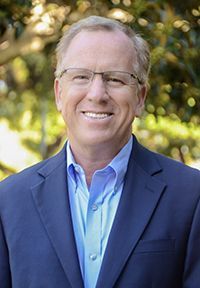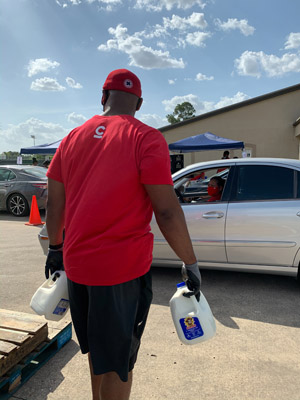When schools, restaurants, hotels, and other places abruptly closed their doors due to the COVID-19 pandemic a year ago, children who relied on free meals at school suddenly had none. Many workers immediately lost their incomes. People were thrust into food insecurity, often for the first time. In the early days and weeks, demand at the nation’s food banks swelled. It’s gone down and up over the year, and in many places remains higher today than the baseline before the pandemic.
Last year, the Greater Cleveland Food Bank distributed 9 million more pounds of food than it had in 2019, said Jessica Morgan, its chief programs officer.
“We’ve dealt with crises before,” she said, specifically pointing to things like economic recessions and major storms. “This was unlike anything any food bank had ever seen before.”
Morgan said pre-pandemic, the GCFB only served clients directly from its location one day a month. It has about 1,000 partner agencies in six counties, which do the majority of distribution. But with schools closed, older volunteers not coming to work at food pantries, and many spaces too small for COVID safety requirements, “we knew that we needed to step up and do something.”
When they set up drive-through distribution at their building, the response was so intense “we shut down traffic three miles in all sorts of different directions.” After three weeks, the food bank arranged to use a large municipal parking lot instead. Those weekly distributions continue.
Across the country, food banks have gotten similarly creative to meet the pandemic demand. Feeding America, a network of 200 food banks and 60,000 food pantries, estimates demand increased 55% last year. Vince Hall, director of the Food Bank of San Diego when the pandemic started and now interim chief of government relations at Feeding America, said along with the challenges, another trend emerged: Even as people who had never previously needed food assistance got in line for help, others who had never volunteered at a food bank came forward to offer it.

Vince Hall, Feeding America
“It was just the most heartwarming and inspiring thing to witness,” Hall said. “People put on their masks, maintained social distancing, wore gloves, washed their hands. … They stood up and said, ‘I heard the need and I’m here to serve.’”
What the food banks had to give out also changed. At the very beginning, many saw dips in the donations from supermarkets as panic buying emptied store shelves. But as government responses kicked in, many food banks benefited.
New partnerships
When Steve Brazeel, of SunTerra Produce in southern California, heard about USDA's Farmers to Families Food Box Program, he looked at his temporarily underutilized warehouse and his eager staff and thought, “Hey, we can do that.” In addition to growing fruits and vegetables, his company is also a packer and shipper. He got on the phone and started calling food banks. Eventually, his company won a USDA contract, worked with food banks in four states and the Navajo reservation, and delivered about 1 million boxes. The program shifted his perspective on how a company like his can help with food insecurity.
“The weirdness of it all,” he said, is “there’s a ton of food that goes to waste and a ton of hungry people.” But he didn’t only distribute food that other customers would reject. With the government funding, the direct line from farmers to food bank clients became affordable for everyone in the chain. He specifically referenced a batch of romaine lettuce that was cut on a Monday morning, packed the next day and delivered to the Navajo reservation for distribution on Thursday.
“That’s faster than any supermarket can get fresh produce from the field into somebody’s hand.”
He said food bank partners were skeptical when he offered to include strawberries because their experience had always been that the fruit arrived on the edge of rotten. He got them strawberries that were harvested the day before.
On the farm side, his team also innovated to reduce expenses. A grapefruit grower was packing fruit into boxes that were then unpacked and thrown away because the grapefruit had to be placed in the program boxes.
“We started using his recyclable plastic field crates,” saving time and money, Brazeel said. Now, he says, “a compelling case can be made” for food banks to continue buying fresh produce even after the pandemic, with or without government support.
“We really look at this as an everyday program going forward,” he said, because it’s been “game-changing on a lot of levels.”
The dairy sector is also looking at how to maintain its expanded role in distribution through food banks. Early on, pandemic shutdowns caused the loss of some fluid milk.
“Overnight, our world changed,” said Jacqi Coleman, vice president of innovation partnerships at Dairy Management Inc. “Manufacturing facilities cannot change overnight.”
But processors, suppliers and distributors quickly came up with modifications to meet the need. Cheese blocks no longer going to restaurants were cut and packaged appropriately for food banks. Schools got permission to distribute gallons and half gallons, instead of half pints, of milk.
Coleman said within weeks, there were truck drivers, processors and other partners helping get milk, cheese, yogurt and butter to food banks — 469 million pounds of dairy products from July 2019 to July 2020, For the current (July to July) fiscal year, Coleman says dairy is on pace to send 600 million pounds. And there is no sign of letting up.
Interested in more news on farm programs, trade and rural issues? Sign up for a four-week free trial to Agri-Pulse. You’ll receive our content - absolutely free - during the trial period.
“If we get to a billion pounds, that would (allow for) about 50% of what a traditional family would purchase at retail,” she said. A food bank or pantry providing that to its clients is “a pretty good goal to get to.”

A man brings milk to a car at a Houston food bank distribution site. (Courtesy: Dairy MAX)
In addition to repackaging, Coleman said partnerships with trucking companies brought dairy products to food banks when trucks otherwise would have been returning home empty. And researchers at the University of Wisconsin, Madison, developed a virtual product quality training for USDA that allowed for a million-pound government cheese purchase that went to food banks.
Donations increase
Coleman said the intensity of the pandemic need raised awareness about the breadth and depth of hunger and the challenge of getting food to people who need it, especially in rural areas. The increased demand, which strained the existing system, “is not a good thing, but it has elevated the passion and excitement and willingness of people to act,” she said.
That includes individual donors, who have stepped up to support many food banks, and at least one prominent philanthropist. Mackenzie Scott, whose divorce from Amazon founder Jeff Bezos left her with billions of dollars, has made major unsolicited and unrestricted gifts to 42 food banks. In Cleveland, Morgan called the 8-figure gift “transformative,” though its exact amount has not been made public. She said a committee is working to decide how to “do the right thing with these dollars.”
The Food Bank of Alaska, which distributed 43% more food in the second half of 2020 compared to that period in 2019, received a $3 million gift from Scott.
“Her gift gives us an opportunity to bring hunger relief to more Alaskans — especially during this time of exceptional need,” director Jim Baldwin, CEO of the Food Bank of Alaska, said in a statement. Scott has not spoken publicly about the donations.
“The pandemic has not just awakened people to the problem of hunger today, but also the problem of hunger that has always been there,” Hall said. “One of the greatest challenges for all nonprofits is building capacity, but large gifts enable us to take a giant leap forward.”
The problem of hunger will not go away when the pandemic ends, but the charitable food distribution system may take some lessons from this crisis to make its processes more equitable, accessible and pleasing to clients.
Coleman said throughout the pandemic, she and her colleagues were constantly in a learning mode, trying to improve what they were doing.
“Being in this open mode, looking at innovative ways to reach people, is going to be a lesson learned that we want to continue,” she said.
Brazeel has been pleased and surprised by how successful SunTerra’s partnerships with food banks have been. Regardless of whether the Farmers to Families Food Box Program continues beyond its April expiration, he expects to continue getting fresh produce to food banks.
“It’s a major focus for our company to continue this program in some way, shape or form,” he said. But he emphasized that his role is on the back end, connecting farmers and distributors. He doesn’t actually put food into the trunk of a hungry family’s car — that’s left to the staff and volunteers at local food banks and pantries.
“They’re the real heroes out there,” he said, “doing the last mile distribution.”
For more news, go to www.Agri-Pulse.com.

